Entering the Auto Market at Last / 1966
Supporting Retail Dealers in Their Sales Efforts
The Ministry of International Trade and Industry (MITI) in May 1961 unveiled its basic administrative policy regarding the automotive industry (later called the Specified Industry Promotion Bill). Upon its passing, the bill would make it impossible for any new car company to enter the market. Given the assumed timeline, Honda had to begin automobile production and sales immediately in order to obtain sufficient sales records before the bill's passage.
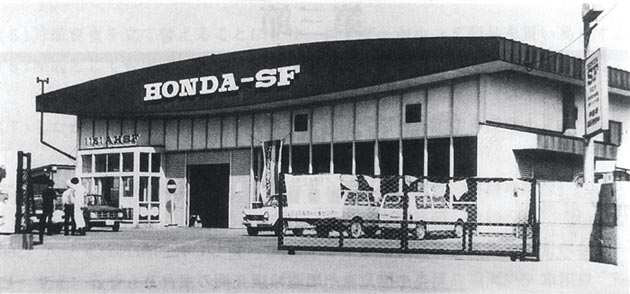
The front view of AHSF's facility in Nagaoka, circa 1968 (Photograph courtesy of Toshinobu Kudo)
Honda's first automobiles, the T360 mini truck and S360/S500 sportscars, debuted in October 1962, at the 9th Japan National Auto Show. Although the cars were well received by the public, the whole affair was a matter of concern to Senior Managing Director Takeo Fujisawa, who felt the company had been rushed into producing cars at least a few years earlier than originally planned. There was still a great amount of work to be done.
Kihachiro Kawashima (then executive vice-president) looked back on the situation in the November 1978 issue of the Honda Company Newsletter (Vol. 151):
Honda was a total stranger to the automotive market at that time. We could not implement nationwide promotional campaigns as we had done for the Cub, simply because we had never sold any cars before. Moreover, the establishment of large retail stores such as those of Toyota and Nissan was out of the question, because that would have required a huge investment, causing us to lose our price-competitiveness. Therefore, Fujisawa thought of establishing a sales network among Honda motorcycle retail dealers who had sufficient financial resources and wanted to get into the car business.
However, these dealers also had certain disadvantages. Although they had strong ties with the local communities, their operations were too small to handle automobiles. To compensate for that weakness through our resources as a manufacturer, and to allow the retail dealer to concentrate on selling, we established systems in which service issues were handled by our SF (Service Factory) network, with the trade-in and resale of used cars being handled by Honda Used Car Sales. Assistance with day-to-day sales operations would be provided by our sales offices, while marketing and other support would be provided by Honda Sales Research (HSR). We had to use our motorcycle retail dealers to sell automobiles. The new support system came into being once we had explored ways of converting their potential power into an effective sales force.
Honda established Honda Shinpan Co., Ltd., at about the same time, in order to expedite financial matters.
This series of support systems was collectively known as Honda's "retailer-based sales system."
Winning Loyal Customers through the SF Network
Honda's first system established to support retail-dealer operations was a network of service factory facilities, or "SFs." In July 1964, Honda began the construction of these facilities, which would deal mainly with repairs and inspections at various locations throughout Japan.
Unlike the models we have today, cars were subject to many repairs at the time, so service operations played a significant role throughout the automotive industry. Fujisawa, well aware of this, thus made a concerted effort to enhance Honda's service capabilities.
Honda saw the establishment of its SF network in October 1967, with 131 facilities nationwide.
Fujisawa spoke about the role of the SF network and Honda's ambition for a retailer-based sales system at the General Meeting of Specialty Dealer Representatives held at the Suzuka Circuit in the fall of 1968:
"Honda has spent 15 billion yen in building this SF network. To give you an example of the extent of our investment, the 15 billion yen could buy all the factories of Suzuki or Daihatsu and still have some money left over.
"However, Honda is not generating any profit whatsoever from this SF operation. We are merely offering the network as a tool that you can use to win loyal customers. The 15 billion yen is an investment that we have made in order that your customers might come back again and again.
"Since Honda has clearly focused on the retailer-based sales system and is getting good results with it, we hear that other manufacturers have been contacting you, saying that they are also adopting retailer-based sales systems. If they try to lure you with the phrase 'retailer-based sales system,' I suggest that you reply to them with the following statement: 'Honda is selling only through retail dealers by implementing voluntary measures to prevent direct sales. If you claim that you too are adopting a retailer-based sales system, please show me how you will prevent direct sales. If you can publicly announce that you no longer employ direct sales, then I will accept that yours is a genuine, retailer-based sales system.'
"If the manufacturer says they will market only through retail dealers, and that they will not use direct sales, please do business with them as you do with Honda. This way we know we are competing on a level playing field according to fair business practices.
"However, please check with them about how they handle repairs and inspections. After all, you will be in this business a long time, and we do not want you to lose the big picture by merely pursuing short-term profits."
Pursuing a Scientific Approach to Sales
The word technology applies to many activities other than those associated with a company like Honda R&D. Honda Sales Research (HSR), for example, was established for the pursuit of sales using a scientific approach, in which the company would study various issues associated with sales operations and reflect those findings in the corporation's overall sales strategy. Founded in April 1966, the company also served as a bridge between Honda and its retail dealers. In contemporary terms, what Honda Sales Research intended to provide was marketing and sales support.
Honda Sales Research had several important characteristics of operation:
[1] Provide a system whereby at the end of the process the actual state of sales operations is identified from a scientific point of view, and the information is fed to Honda Motor automatically.
[2] Thoroughly communicate the philosophy, ideas, and current status of Honda Motor to retail dealers by assisting in the exchange of opinions between the manufacturer and retail dealers.
[3] Promote the sales activities of the existing dealer network.
[4] Ensure that the products are not sold directly to the end user, and that they are marketed exclusively through the retail dealers.
[5] Operate only with sales representatives as a matter of principle, since the nature of business does not require management personnel, office facilities, or even clerical work.
[6] Employ a unique payroll system in which the sales representatives are compensated with salaries comparable to those of expert professionals.
Honda Sales Research placed a newspaper ad in March 1966, recruiting sales representatives. The ad was rather unique, in that it conveyed the following points:
[1] The company is a unique organization designed to pursue a scientific approach to sales, and as such offers a highly motivational work environment.
[2] The company is looking for people who can use their talents as "salespersons with brains," in an environment free of the restrictions so common among traditional organizations.
[3] Each employee will be provided a Honda sports car with which to conduct business.
[4] The company will value expert professionals.
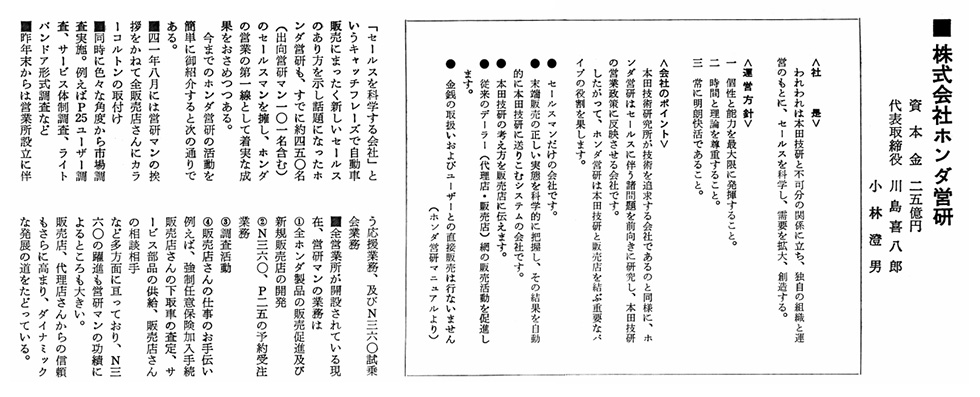
From Honda's internal magazine issued in June 1967.
A large number of applications (3,000 of them, in fact) came in from all over Japan. Through careful screening using written tests and interviews, 127 individuals were hired, becoming the first sales representatives at Honda Sales Research.
"I didn't see many new graduates," recalled Tetsuo Miyagawa, one of the first staff members hired by the company. "The majority of us had working experience elsewhere, and we were people from all walks of life. I even heard that there were people from just about all professions, except medicine and the law. This was because the employment conditions were exceptionally good, including the salary. The whole concept reflected Mr. Fujisawa's desire to employ the most talented people he could find as sales representatives of Honda Sales Research."
New-employee orientation lasting one month was held at the Suzuka Circuit, but the training curriculum was lacking in certain respects, because Honda had no experience in sales procedures involving direct customer contact.
"The lecturers sent from Honda Motor had never taught sales-training classes before," Miyagawa remembered. "Therefore, instead of having experts who could pass on their knowledge to us, training was carried out mostly in the form of discussions."
HSR sales representatives had numerous responsibilities, including selling cars and gathering information about retail dealers in their assigned territories (e.g., the dealer's floor space and repair capabilities). Rather than report to the office each day at a specified hour, though, they were able to set their own work schedules. If necessary, they would go directly to the place of business in the morning and straight back home at the end of the day. This kind of work format was totally new at the time. Where sales activities were concerned, the HSR representatives could accompany the owner of the retail dealership in order to negotiate a sale with the customer, or deal directly with the customer by acting on the owner's behalf.
"Following the release of the N360," Miyagawa recalled, "our customer base grew to encompass salaried workers. Most of these customers had never even purchased a car. Therefore, they and their families would be very excited about everything I said. I found the sales negotiations to be really enjoyable."
Honda Used Car Sales was established in April 1966 to handle overall operations involving such vehicles. In order to achieve this, the company's primary task was to streamline the distribution channels for used cars and develop an entirely new market segment. The company had certain specific objectives, as follows:
[1] Reduce the burden on retail dealers in taking in trade-ins on new cars; namely, to provide a means of liquidating used-car inventories.
[2] Sell quality, used Honda cars in order to enhance the brand image and maintain the high resale value.
[3] Set up a national network for the distribution and sale of used vehicles.
Honda also established Honda Finance at about the same time, for accepting monthly installments from customers who purchased cars through Honda Sales Research.
The SF network that had previously been established had managed a significant expansion. In 1967, one year after the establishment of Honda Used Car Sales, AHSF (All Honda Service Factory) was set up via an extensive network encompassing most of Japan. Through efforts such as these, Honda's retailer-based sales system took root quickly.
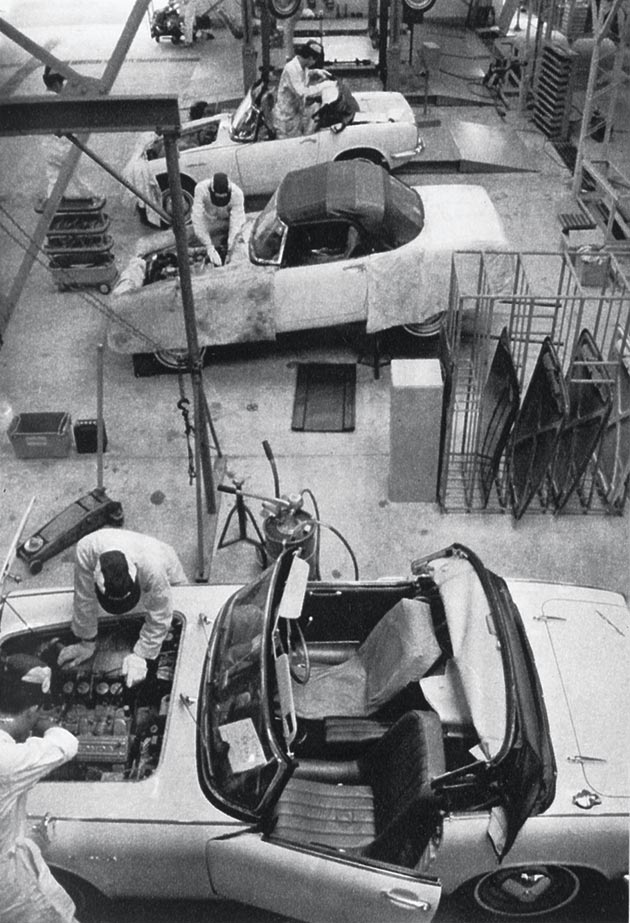
Engineers conducting inspections and repairs at AHSF's Tokyo Branch in Sumida Ward (October 1964)
Sales Offices: Uniting the Retailer-Based Sales System
The Honda auto sales network, built upon the foundation and resources of retail motorcycle dealers, had thus adopted the same distribution channel used for motorcycles, in which products were first shipped to the wholesale distributor and then to the retail dealer. However, as operations grew, the wholesale distributors became more dependent on direct sales. Accordingly, their role of promoting business on behalf of the retail dealer gradually diminished.
Fujisawa believed that in order for Honda to establish a successful retailer-based sales system, it had to grasp the real issues facing retail dealers and to implement the appropriate growth measures. Otherwise, Honda would not have an effective sales network with which to compete with other manufacturers who had entered the market early. Therefore, after careful consideration, he decided to establish sales offices so that Honda could ship its new N360 mini passenger cars, which were scheduled for launch in March 1967, directly to retail dealers rather than the wholesale distributors.
The LN360 and TN360 commercial vehicles, on the other hand, continued through the conventional channel and were shipped to retail dealers via wholesale dealers. Still, it was forbidden for the wholesale distributors to sell these models directly to end-users.
Once it had announced the launch of its N360 in November 1966, Honda began to establish sales offices throughout Japan. By spring of the following year, offices had been set up in seventy key cities, enhancing Honda's retailer-based sales system by strengthening the strategic relationship connecting the SF network, Honda Used Car Sales, Honda Sales Research, and Honda Finance. With that, the company's retailer-based sales system had at last become operational. Honda employees were appointed as sales-office managers, but this was despite the fact that many of them had little prior experience in that area.

The sales lot at Honda Used Car Sales - Ueda Center, circa 1971 (Photograph courtesy of Makoto Takahashi)
Yoshihide Munekuni, who worked at sales offices in Aichi, Fukuoka, and Kagoshima Prefectures from 1967 through 1974, looked back on the experience:
"When the sales offices were established, each office had a limited number of staff and a very modest budget. Furthermore, only few people were driving Honda cars at the time, so we had to think of ways to convey our message efficiently to greater numbers of people. Whenever I was transferred to a new location, I would first go to the local city hall and study the nature of the residents, along with the community events and history of the town."
Munekuni and his colleagues would create a yearlong calendar listing the town's major events. Then, with the calendar, they would identify places where people would gather so that they could display the cars there. For example, they brought cars to the town's port at four o'clock in the morning when the fishing ships would return from sea. In the fishing village, the salesperson's day would begin with the return of ships to port. On their way back from port, they would place flyers in the mailboxes of homes as the newspapers were delivered. At lunch, they would bring the cars to municipal offices and companies to show them to people at work. At night, they would target local festivals.
"We did all these things together with the retail dealers. It helped us build trusting relationships, without which customer loyalty would not have been possible," Munekuni said.
"During the time I spent at sales offices, I made it my goal to give customer satisfaction the top priority, in keeping with the company's basic principle. People in sales offices have the advantage of being able to listen to customers and retail dealers directly. Such an advantage means, however, that we must observe the market with our own eyes, without assistance from others, and that we should maximize customer satisfaction using the time and resources available. I used to think of this as the responsibility of the sales office, since it was the closest point of contact between the manufacturer and customer.
"Accordingly, our responsibility to the manufacturer and customer meant that we had to unite SF, Honda Used Car Sales, and Honda Sales Research as an overall operation. For example, in Kagoshima, we purchased a parcel of land in order to set up three offices on the same premises. Thus, we went from diversification to centralization. In those days, it was quite uncommon for a regional sales office to purchase its own land, but I had decided to propose it in the spirit of company ideals. As a result, we were able to provide better service. With it, we achieved more customer satisfaction among our customers and retailers."
A Thorny Path: Fostering Retail Dealerships
Honda had fully established its retailer-based sales system. Subsequently, a number of sales strategies were implemented before the company finally established a dealership network under the name of "Verno."
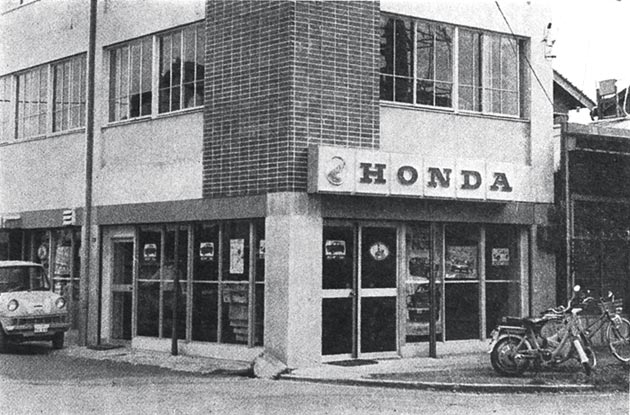
A front view of the Shizuoka sales office, which opened in April 1967.
In 1968, a specialty dealer system was set up in order to reward those retail dealers who had sold more Honda cars. Among other things, it provided business assistance and included them in Honda's employee benefits and welfare programs. Then in 1969, the Class-A dealer system was introduced. Under that system the specialty dealers that could commit to the Honda brand as their mainstay product line were designated "Class A" and given preferential treatment. Yet, through the implementation of such policies, designed to elevate high-performance dealerships above their peers, several open points [or, areas without sales outlets] came into view. This led to the introduction of another plan, to be known as "OP One (OP I)."

Exhibitions were held in various locations in order to garner attention to the opening of Honda's first sales offices. The photograph shows an exhibition in Hiroshima Prefecture, circa 1968. (Photograph courtesy of Noboru Oyama)
The purpose of OP I was to assist entrepreneurs in the industry who wanted to become independent and open their own retail dealerships, but who had been held back by the lack of funds. The plan was to establish stores at selected open points through Honda Finance, whereby the facilities could be leased to them.
The OP II system was introduced in 1972, following the grand opening of Honda Higashi Okayama, its first store. The new system was intended to disseminate Honda's business strategies more effectively than before, so in addition to leasing the land, building and capital through Honda Finance, Honda would appoint a store representative (general manager) and sales staff [the persons responsible for store operations] from among the employees of Honda Motor, Honda Sales Research, and Honda Used Car Sales. The SF personnel pool acted as a source for service staff.
The OP II stores, which provided certain services in addition to sales, were larger in scale compared to the retail dealerships. Moreover, they were the first such facilities under Honda's direct control. Their establishment reflected the needs of Honda customers who wanted to obtain service at the same place where they had purchased their cars, since it was becoming more difficult to sustain customer loyalty through the conventional retailer-based sales system, in which the retailers were involved in sales exclusively. A shift in Honda's business direction was another reason for the existence of these new stores. The company was expanding its product mix, changing its mainstay models from mini automobiles to compact cars (registration vehicles).
"The OP II system," said former Chairman Koichiro Yoshizawa, "was introduced to create stores of a size appropriate to the sale of compact cars, and to provide them with the capabilities needed to service the product and maintain customer loyalty. However, the plan resulted in a drastic change in approach regarding the retailer-based sales system. We had heard certain comments criticizing us for breaking our promise not to get into direct sales, and the people implementing the system faced considerable difficulties during the early stages of introduction. Though we chose what we called 'open points,' the stores had to compete with nearby retail dealers.
"OP II represented our model stores, and we didn't hesitate to provide materials and assistance to those who were eager to grow. So, the OP II system had a unique position among the sales strategies we'd implemented in order to foster retail dealers."
Honda introduced the franchised dealer system in 1972, thus promoting the independent operations of its automobile dealers as specialty stores. Subsequently, with the launch of the Civic, the company introduced a similar system for stores that were more modest in scope. In those days, the retail dealers who made an effort to maintain close customer contact saw themselves grow with the times, while those who had failed to do so soon disappeared. Concurrently, the wholesale dealers who had demonstrated an understanding of Honda's sales strategies succeeded in becoming large-scale franchised dealers. Under this system, the franchised dealers enjoyed relatively greater independence than their retail counterparts.
Creating the Ultimate Sales Network
Despite significant growth in the auto industry as a whole, Honda's sales volume experienced a drop in 1969, due to the public's awareness of a problem in the N360. It was a decline that continued into the 1970s, one reason for which was the Honda sales network's inability to sell more cars. Toyota and Nissan were at the time selling 1 to 1.3 million cars annually through their existing sales channels (four for Toyota and five for Nissan). Honda was selling 250,000 cars annually, but that figure was acceptable in light of the fact that the company had only one sales channel.
Honda therefore decided to set up a new sales channel by which to market its new Prelude, which was scheduled for a fall, 1978 launch. Accordingly, the Verno dealership network was established in November of that year. In order to achieve this, Honda sent invitations to its dealers [primarily the franchisees] across Japan. Many stores expressed their interest with the intention of bringing in their own capital, while those who did not have sufficient funds could participate in joint-venture agreements with Honda Motor. Moreover, there were newcomers who provided complete financing for the establishment of dealerships. In markets where no such candidates could be found, Honda Motor opened stores under direct control.
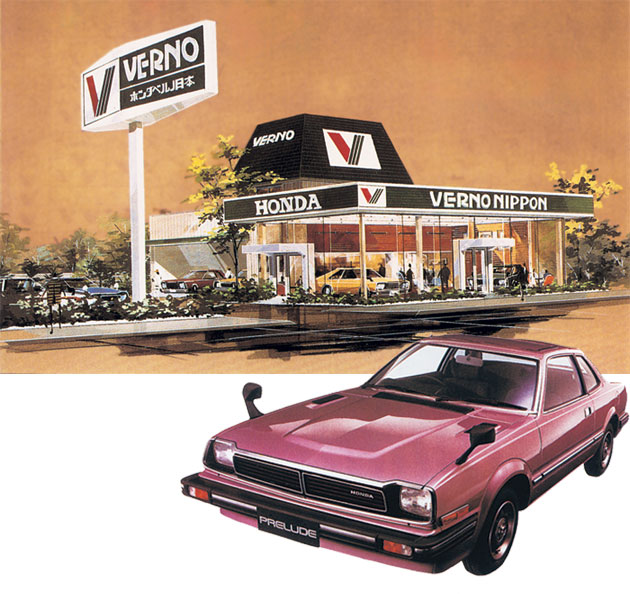
An image sketch of the Verno network of retail stores, featured at the official launch. The sketch depicts the store logo along with the Prelude, Verno's primary model. Subsequently, the Clio and Primo networks carried different models and adopted different image colors in order to emphasize their unique characteristics.
Compared to the conventional retail dealerships, which had proliferated rather spontaneously, each Verno store's location was strategically determined by Honda, based on market size. This was Honda's first attempt at implementing the new concept of PMA (primary market area). Based on this concept, Honda identified key market areas and put forth increased effort to achieve sales activity. Honda subsequently introduced its Clio and Primo dealer networks in July 1984 and January 1985, respectively, giving the company a total of three domestic sales channels. Describing the purpose of that system, Munekuni said, "In those days cars were being sold mostly door-to-door in Japan. In order to conduct sales more efficiently by making customers want to visit the stores, Honda departed from the traditional approach by introducing an original, clear-cut three-channel system, which was designed to offer different model lines through different sales-and-service configurations.
"The use of different colors provided a clear distinction among the three kinds of dealerships. For example, the Primo stores used red as their image color and sold economy cars like the Civic. The Clio stores adopted silver as their color and sold the Accord and other upscale models. The Verno stores carried sports models such as the Preludes, using green to convey their image. The unique feature of each dealer network was clearly communicated by the range of models they carried and the colors they used.
"We also enhanced our CS (Customer Satisfaction) programs as a means of satisfying the customer who had purchased a Honda and making them want to come back. The new sales system was designed for efficiency in all respects."
Automobile dealers are currently experimenting with new sales methods such as unmanned, automated stores and selling through the Internet. Then, in September 1998, Honda also began operating a test store called HEAT (Honda Exciting Active Terminal), in Kanagawa Prefecture.
SF, HSR, and Honda Used Cars: A Major Shift in Roles
The three companies that had united to form a successful retailer-based sales system [SF, Honda Sales Research, and Honda Used Car Sales] had over a period of years undergone a significant shift; a change in direction reflecting changes in customer needs, Honda's strategies and the tenor of the times.
After twenty years, though, the SF operation closed its doors, making way for the establishment of Honda Service, which took place in July 1984. The purpose of this new company was to integrate domestic service operations, parts supply operations, and former SF operations, thereby enhancing Honda's service system in Japan. Honda Service also had a very different focus of business: The company encouraged proposals regarding management, and promoted educational programs to support independent operations among retail dealers.
Honda Used Car Sales changed its name in February 1970 to Honda Chuhan and again changed its name to Honda International Sales (HISCO) in February 1974, when it began selling Ford cars. However, Honda decided to dissolve HISCO in October 1995 in order to form a trinity system that would bolster each of its retail dealers' three main functions: new car sales, used car sales and service. As HISCO folded, Honda Used Car Sales was revived to implement Honda Motor's used-car sales strategies through its retail dealerships.
The natural evolution of Honda's sales system dictated that Sales Research would eventually close, which it did in April 1974. The decision was made in consideration of the accrued sales knowledge and skills possessed by the retail dealers, which had obviated the need for support from HSR sales representatives. Thus the employees of Honda Sales Research were transferred to Honda Motor and assigned to sales offices or other positions of similar responsibility.
Honda Shinpan Co., Ltd., changed its name to Honda Finance Co., Ltd., in April 1988. It is still in operation today.
Closer to the Customer
Every sales strategy must change with the times. Since the goal of every sales activity is to meet customer needs, the sales plan and the sales networks must fit the current situation.
However if that is so, are there any values that are constant and reflected in every strategy? According to Kawashima and Tamotsu Nakano (former company director of Honda Motor), Fujisawa always had two things in mind from the viewpoint of the company's role as a manufacturer.
The first was to achieve a closer relationship with the customer. To do so, the company had to think of ways of selling better, more affordable products and providing better service. This would be done by refining distribution and service channels.
The second point was to motivate retail dealers so that they could grow together with Honda, and determine what should be done as a manufacturing company to achieve those objectives.